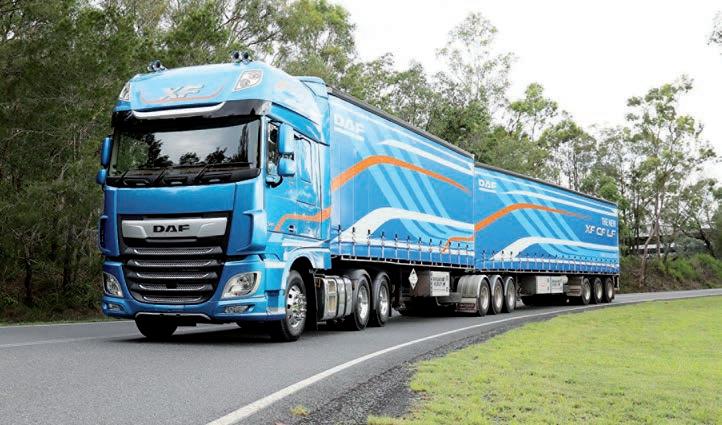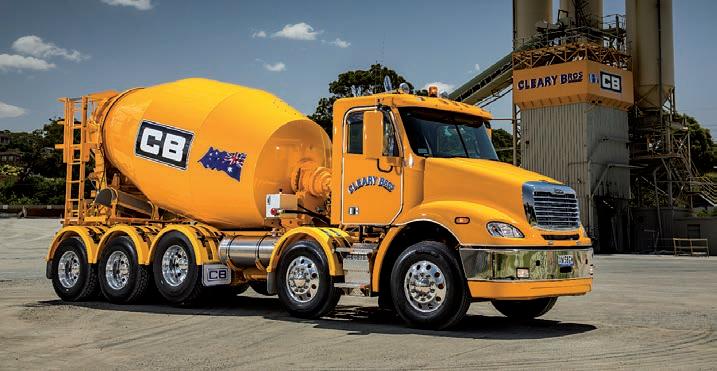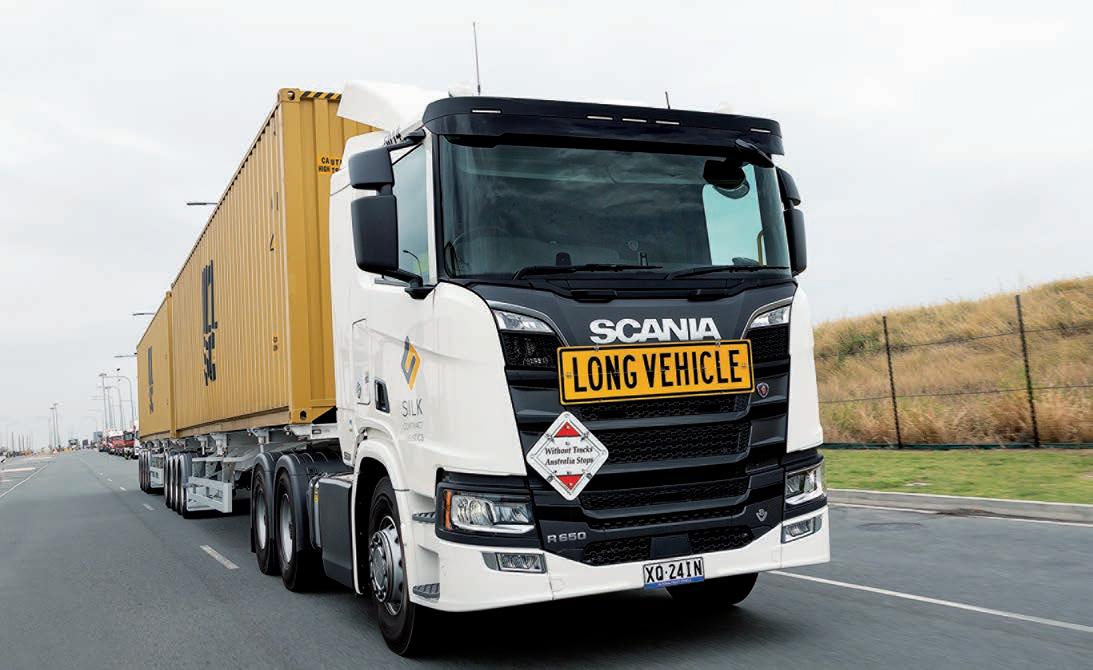
7 minute read
Control V
The new Hino 300 4x4 series.
Safety systems have played a major role in impacting freight movements in Australia. None more so than Vehicle Stability Control which has done much to improve safety on our roads.
Vehicle technology has developed to reduce the likelihood of accidents caused by a number of factors including, but not limited to, human error, inclement weather and adverse road conditions. Vehicle Stability Control (VSC) was first offered in cars in the late 1980s. The system includes both roll control and yaw control that autonomously corrects oversteer, understeer and rollover situations. Roll control systems sense the lateral acceleration of a vehicle and reduce the risk of rollover through reducing engine torque and strategically applying selected brakes. Yaw control allows the driver to point the vehicle in the desired direction, with individual wheels braked to maintain directional stability. In heavy vehicle applications, VSC can only be fitted to powered units such as rigid trucks and prime movers. Roll Stability Control (RSC) can be fitted to trailers and also provides significant safety benefits by mitigating the likelihood of rollovers. RSC provides roll control in a similar manner to VSC but does not include yaw control. While stability control systems will not prevent all rollover incidents, both VSC and RSC allow a driver to maintain control of their vehicle with the aim of ideally avoiding or at the very least reducing the severity of a rollover or other incident. As a Toyota group member, Hino has been at the cutting edge of safety developments in trucks over the last two decades, having cleverly adapted Toyota passenger car safety technology to suit commercial vehicle applications. Back in 2001 with the release of the light-duty Dutro, forerunner of the 300 Series, Hino became the first to market with SRS driver’s airbag, disc brakes and ABS on a light-duty truck. By 2011 Hino’s 300 Series became the first light-duty truck with standard VSC, with this precedent flowing through to the medium-duty 500 Series Wide Cab and Standard Cab versions in 2017 and 2019 respectively, and subsequently the 300 Series 4x4 in 2018. Subsequent to this, the company now offers VSC as standard equipment on every model from its 300 Series that can be driven on a car licence, through to the 500 Series 6x4 350hp FM variant. Daniel Petrovski, Hino Australia’s Manager of Product Strategy, explains that the benefits of having standard VSC across the light and medium-duty Hino range are far-reaching, and even more so with the 300 Series 4x4 model. “VSC has long been recognised as a lifesaving system both on and off-road, and there are some mines that now accept that if a vehicle is so equipped and also has an ECE R29 compliant cab then the
requirement for a rollover protection system (ROPS) is negated,” he says. “This saves around 350kg on the front axle and $10,000 plus on the cost of supplying and installing the ROPS. We’re the only Japanese manufacturer with VSC and disc brakes on a light-duty 4x4. The others have drum brakes with ABS only.” More than 90 per cent of the vehicles that Hino has sold in the past year are equipped with VSC. In addition to VSC, Hino introduced PCS (Pre-Collision System) as standard on its 500 Series Standard Cab range in early 2019 and now on its latest 300 Series. Also known as Advanced Emergency Braking System (AEBS), PCS uses a radar to monitor the distance between the vehicle and objects ahead, automatically applying the brakes if it senses a collision is imminent. “You can’t have PCS without VSC,” Daniel says. “We have equipped all our light and medium-duty models with VSC to enable PCS as the next level in safety protection for our customers.” At the heavier end of the market, PACCAR’s latest DAF range is also equipped with VSC as standard, with PACCAR Brand Manager Tim Car saying the recently superseded Euro 5 DAF 6x4 prime mover models were also fitted with VSC as standard. “With our new Euro 6 models, VSC is standard across the board,” he says. “This
Vehicle Stability Control is now standard on new Euro 6 DAF models. Latest Cleary Bros Freightliner Columbia agitator with VSC.
safety technology is already mandated in Europe and we get the benefit of carrying this over to our Australian range. With the latest range we are now up to Version III of EBS which is included in all the new products coming from Europe which are calibrated for our local road conditions at the Eindhoven factory.” The Eindhoven engineering team has committed to extensive development work to ensure the system is right for Australian conditions. Tim says customer feedback has always been positive in respect of the safety systems installed in DAF trucks and that the mandating of VSC on trucks will be a great advantage to the drivers and other road users operating around the trucks. He also highlights the added benefit of


‘smart’ trailers – those equipped with RSC – where the electronic stability measures flow through to the trailer, making the entire combination safer. The VSC fitted to Euro 6 DAF prime movers is compatible with single trailer and B-double combinations. “The inclusion of all the safety packages including VSC provides a safer work environment for drivers and DAF is in a strong position in this respect with the level of safety equipment that is furnished as standard with our new trucks,” Tim says. DAF Euro 6 models offer, as standard equipment, adaptive cruise control (ACC), forward collision warning (FCW), advanced emergency braking system (AEBS-3), lane departure warning system (LDWS), vehicle stability control (VSC), protective cab suspension and construction and driver’s air bag with two seat belt tensioners. When it comes to operating concrete agitators, Steve Crandell, General Manager Concrete & Transport at Cleary Bros (Bombo) near Wollongong, believes VSC is a non-negotiable. “For high centre of gravity trucks like agitators I wouldn’t run without VSC,” Steve says. “It’s the first thing you look for in the specifications when you’re searching for a new unit and you wouldn’t put one on the road without it.” The two newest trucks in the fleet are Freightliner Columbia
Scania R 650 on road in Brisbane for Silk Contract Logistics.
CL112 10x4 agitators which can carry 7.6 cubic metres of concrete per load, with a gross vehicle mass (GVM) of 31.5 tonnes allowed under Mass Management. “We received our first unit two years ago and the second around 12 months later and we couldn’t be happier with them — Kip Sandercock they have good build quality and are a perfect fit for the application,” Steve says. Running trucks at the higher end of the weight spectrum with Gross Combination Masses (GCM) of more than 100 tonnes in some cases, Kip Sandercock, National Transport Operations Manager of Silk Contract Logistics is equally enthusiastic about the value of VSC and RSC that are standard features across the company’s fleet of prime mover and multi-trailer combinations.

The fleet includes Scania R 620 and R 650 prime movers hauling Performance-Based Standards (PBS) approved A-doubles at weights ranging from 86 to 119 tonnes GCM, the latter only operating within the Port of Brisbane precinct.
National Transport Operations Manager, Silk Contract Logistics
“We have 10 of the 86-tonne GCM units which we run out from Brisbane through Toowoomba and Goondiwindi, sometimes as far as Wee Waa in northwest NSW,” Kip says. “The VSC is intrinsically linked to the PBS arrangement of the combinations and you have to have the right prime movers that are capable of controlling the EBS systems on the trailers.” What’s interesting about the system, according to Kip, is the way individual brakes are applied at exactly the right pressure to arrest the instability. “If you get a sway on the back trailer and you apply the brakes it just pulls it back into line perfectly without any wheel lockup and this extra control is the reason why you’re allowed the extra payload capacity under PBS,” he says. VSC can also sense when a vehicle is at risk of becoming unstable and automatically applies the correct brakes in sequence to bring it back under the driver’s control. Silk carries containerised cotton and grain, with two 40 foot containers carried on each A-double combination. The highly effective hydraulic retarders fitted to the Scanias, ne plus ultra for descending steep grades like those of the Toowoomba Range, along with what he describes as amazing fuel economy, have been main driving factors for choosing the Swedish brand according to Kip. VSC in its various iterations is one of the most valuable contributors to safe commercial vehicle operation in everything from the light-duty Hino at 4.5 tonnes GVM through to the A-double combination under PBS at 86 tonnes GCM.






